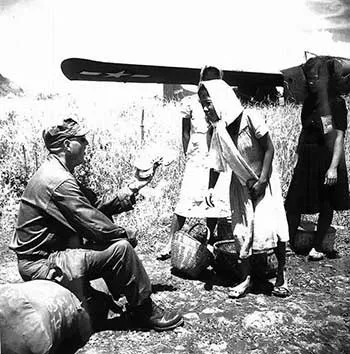Unlucky 13th Plane Crashes as the 11th Airborne Leaves Lipa for Okinawa in 1945
[In this article: unlucky 13, 11th Airborne Division, atomic bomb, Hiroshima, Nagasaki, Lipa City, Batangas, Lipa airstrip, World War II Batangas, Lipa plane crash]
With the overcoming of Japanese defenses at Mount Malepunyo on 30 April 1945, the United States Army, in particular the lead group 11th Airborne Division, for all intents and purposes had liberated the Province of Batangas from Japanese occupation. All that was left for the United States Army in Batangas was to flush out and mop up pockets of Japanese stragglers who managed to escape the last major battles1.
Exhausted soldiers bivouacked in Lipa for much needed rest and recreation. In anticipation of an invasion of Japan, however, the troops continued to train to stay sharp. A parachute school was even set up at the Lipa airstrip to train fresh troops who had just arrived from the United States.
READ: “The 11th Airborne Earns Rest in Lipa after Liberation of Batangas in 1945”
As things happened, the 511th’s role would change from being part of an invading army to that of an occupying one. On 6 August, from the B-29 Enola Gay, the United States Army dropped the first of its two atomic bomb over the Japanese city of Hiroshima. Early in the morning of 9 August, this time from B-29 Bockscar, a second atomic bomb was dropped over the city of Nagasaki2.
The direct consequence of the above developments was that Japan was forced to the negotiating table, thus sparing the United States an expensive – not to mention extended – campaign in Japan. Maj. Edward M. Flanagan Jr., in his 1948 book, explained how the 11th Airborne received this new development:
“Now when we heard that they wanted to surrender we were hopeful and quietly thankful... There was no feeling of gaiety or hilarity; but rather a grateful let-down feeling of thanks that at long last it was over and done… They were a beaten, bombed, burned-out nation and wanted nothing more than peace. We now heard officially that our Division had been selected to spearhead the victorious Allied occupation of Japan.”
 |
| Troops of the 11th Airborne are seen boarding a transport plane. Image source: United States National Archives. |
The division was expecting at least a couple of days’ advanced notice to prepare to ship out from Lipa, but on 11 August, just two days after the second atomic bomb was dropped over Nagasaki, it was given instructions to prepare to move out “sometime in the future.” “Future” actually turned out to be that very same day.
By noontime, orders were received stating that the division’s troops should get ready to ship out. Planes that would take them to Okinawa, where they were to pitch camp before hopping on to Japan, would start arriving in as short as four hours. Aside from Lipa Airstrip, the division would fly out from Nichols Airfield (presently Villamor Air Base in Pasay City), Nielsen Field3 (in Makati, now defunct) and Clark Airfield (Angeles).
Flanagan described the alacrity with which the troops were rounded up:
“By 1300 on the 11th all men had been recalled from rest camps. Those who couldn’t get back from passes in time to make the planes were to come up by boat with the rear echelon. The movement was a miracle of hurried packing, loading, and planning. Not until the planes appeared over Lipa Airstrip did a unit know whether it would load in C-46s or B-24s. Only by remaining alerted in unit areas, with trucks (borrowed from units all over Luzon) standing by to transport men and equipment to the air field, was the movement successful. Speed was the keynote of the entire operation, but care had to be taken to land in Japan with complete combat equipment.”
 |
| A soldier of the 11th Airborne buys bananas from a native near the Lipa Airstrip before shipping out to Okinawa. Image source: United States National Archives. |
The soldiers did not seem to mind the short notice. After all the 11th Airborne would enjoy the distinction of being the first division to be deployed in Japan and it was a certainty that they would make the headlines back in the United States. Before long, the different units started to board the planes to which they were assigned and the first few B-29s started to take off without incident for Okinawa.
But without warning, the following day – the 12th of August – the curse of the number 13 stuck, bringing tragedy to the 11th Airborne. The incident was exacerbated by the fact that among those who perished were soldiers who had managed to survive all that the war could throw at them but would be killed just when peacetime was within sight. Flanagan described what happened:
“We were using B-24s to transport personnel, and the first twelve took off successfully with twenty men aboard each plane. The thirteenth, however, never gained sufficient flying speed to take off, and raced crazily across the road at the west end of the strip to bounce off an embankment, and crashed in flames in the field on the other side. Eleven men from the 511th died in the wreck. There would have been more had it not been for the heroic work of Lieutenant Headly G. Ryan who was in the plane when it crashed. The B-24 was burning furiously, and ammunition belts carried for the plane's guns, in case the Jap intentions were not honorable, began to explode. Though injured himself, Lieutenant Ryan carried one man out with him and then returned to the plane twice more to drag injured men to safety through the roaring inferno of the plane. He was awarded the Soldier's Medal for his heroism.”
2 “Atomic bombings of Hiroshima and Nagasaki,” Wikipedia.
3 “Nielson Field,” Wikipedia.
4 “Japanese Instrument of Surrender,” Wikipedia.
